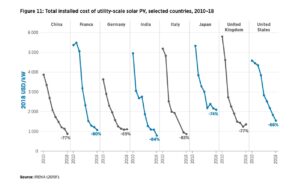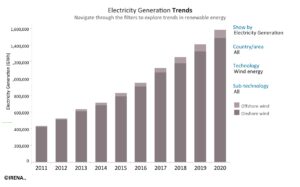Recently, we argued that we are near ‘peak energy’. Global energy demand has slowed down a lot; it will probably peak within a few years. But solar and wind energy are in the middle of a take-off. What are the consequences?

Solar and wind energy: facts
First some facts. Global installed wind capacity grew from 220 GW in 2011 to 899 GW in 2022. An annual growth of 14%. Global installed solar electric capacity grew even twice as fast, from 74 GW in 2011 to 1,061 GW in 2022. An annual growth of 27%. Most new electricity generating capacity consists of solar and wind energy; taken together they took a stunning share of 83% in 2022. The world installed 650 million solar panels in 2022, which boils down to 1,200 solar panels per minute. The number is still growing, this year the world might even hit 2,000 panels per minute. China installs most panels by far – 95 GW, four times as much as number 2, the US (22 GW). But in per capita terms, Australia and the Netherlands have most panels in 2022, both over 1 kW per capita.
Solar and wind energy received a boost from the Ukrainian war. Imagine, energy flows being cut off by hostilities between distant countries. Whereas each country can produce its energy purely from local sources – solar, wind, biomass and geothermal. Some countries might have a harder time doing so than others. The Netherlands for instance, small and densely populated, will have to source much of its energy on the North Sea. In the form of wind farms, so far. But these farms may host solar panels as well – commercial shipping is not allowed anyway in between the wind turbines. Tests are underway.
The importance of ongoing innovation
Another factor is ongoing innovation, particularly with solar panels. Industry expects to halve the cost of solar electricity by 2030 – and solar electricity is cost effective in most places already. There are new technologies like tandem cells, consisting of a translucent cell on top of a silicon cell. They use different wavelengths for electricity production; the cells have efficiencies 1.5 times higher than existing cells.
Moreover, there are production innovations coming down the pipeline that will reduce the amount of costly materials such as silver and silicon. Bifacial modules are in development, which allow panels to capture solar energy from both sides. And there are developments around the integration of solar panels into homes, businesses and power systems. Like better power electronics and the use of more low-cost digital technologies. And we should not forget that solar can be installed easily and quickly – both on a very small and a very large scale. The International Renewable Energy Agency (IRENA) projects solar electricity prices to be 10 to 25% of the 2018 level by 2030, with further price reductions in subsequent years. All in all, the future looks bright for solar energy.
Policy measures gain in importance
Changes of such a magnitude, based on technologies fundamentally different from the dominant ones, require intensive accompanying policy measures. The stakes are high, for solar power needs to succeed in order to reach climate goals. We need education and skills policies that equip the workforce with adequate skills, and increase opportunities for local employment (and prospects for future jobs are bright). We need a more balanced solar industry, no longer concentrated in just one country (China). Each continent should have an industry of its own – not an easy goal, starting from the present situation. Industrial policies should be tuned towards such a goal. Such a policy should be accompanied by technology development, adequate regulation, political support and public awareness. Technical standards and quality measures should be up-to-date. Grid integration and grid flexibility are of the utmost importance. Solar industry should be supported by financial policies and should have good access to capital. It should adopt economies of scale and innovative business models itself. There is a bumpy political and financial road ahead, whereas there are less technical constraints now.
As a US government study concludes, at least land availability does not limit solar deployment. For those who doubt whether we move on this track too fast: the benefits far outweigh additional costs incurred. But the report also warns for an unequitable distribution of costs and benefits. Some might benefit more than others. Energy-related decision making may cause social injustice. Solar project siting may cause benefits to some and harm to others. And the disposal of solar materials is an as yet unsolved problem. In short, the majority of technical problems seems to have been solved; now we are faced with the even more difficult task of devising adequate policy requirements.

Wind
In comparison, many onshore wind turbine projects meet with more public resistance than solar panels. Particularly if they are sited in densely populated areas. Together with obstacles like permitting, and grid connection and integration, this limits onshore wind growth. Resource prices such as steel have risen in the past few years. Wind turbine builders try to counteract higher prices by developing higher wind turbines. At higher altitudes, wind speeds are higher; higher masts also allow for longer turbine blades – both factors contribute appreciably to yields. But bigger turbines do not contribute to better public acceptance. The IEA expects onshore wind turbine growth to remain at the present level, at most.
Growth can be expected however from offshore wind parks. Here, public perception doesn’t limit turbine size. Offshore is much smaller still than onshore wind, but it is growing fast. The North Sea was the main theatre of offshore wind turbine additions in the past few years; but new players like France and the United States are catching up. The share of offshore capacity in overall annual wind additions will reach over 20% in the years to come, up from 5% in 2020. Developments like rapid cost decline and earlier commissioning of projects could still accelerate this development.
Towards net zero 2050?
However impressive the growth of solar and wind energy so far, the IEA warns that this will not be enough to reach the stated goal of Net Zero in 2050. Yes, solar and wind energy are rapidly taking over global electricity markets. At the present pace of development, solar and wind together could supply all global electricity in 2032. But the electricity market is just 15% of the global energy market; even though it is bound to grow because of factors like electric transport. Moreover, as markets get saturated, the pace of development will slow down. The world needs to step up its efforts to secure a renewable energy future!
Interesting? Then also read:
Solar and wind energy: increasing recognition
Towards a sustainable grid
A Marshall plan for European solar PV production capacity
